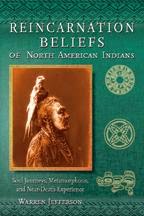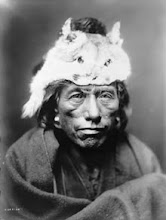That’s My Chair: The Gitxsan Reincarnation Case of Rhonda Mead
This contemporary rebirth story is by Antonia Mills, professor of First Nations studies at the University of Northern British Columbia, Canada. She has been doing research with First Nations of northern British Columbia since 1964, first with the Dane-zaa (Beaver Indians) and then with the Gitxsan, beginning in 1984, and the Witsuwit’en since 1985. She served as an expert witness for the landmark Delgamuukw land claims case. She is the author of Eagle Down Is Our Law: Witsuwit’en Law, Feasts, and Land Claims (1994), co-editor (with Richard Slobodin) of Amerindian Rebirth: Reincarnation Belief among North American Indians and Inuit (1994), and the editor of Hang Onto These Words: Johnny David’s Delgamuukw Evidence (2005). She is currently working on the book "That’s My Chair: Rebirth Experience of the Gitxsan and Witsuwit’en," assisted by a grant from the Aboriginal Social Sciences and Humanities Research Council of Canada.
Rhonda Mead’s Story
Since the summer of 1984, I have been documenting reincarnation belief among the Gitxsan, a First Nation tribe whose ancestral home is in northern British Columbia, Canada. My first trip to the Gitxsan was at the invitation of Ian Stevenson, the pioneer of reincarnation studies, who had been investigating cases of reincarnation within the Gitxsan and other First Nation tribes in British Columbia and Alaska. Dr. Stevenson told me that there was a Gitxsan family that claimed an elderly relative had reincarnated as her own great-granddaughter.
This story had all the classic characteristics of being a Gitxsan rebirth case: the elder, Susan Albert, had made a prediction she would return after death; after she died, she appeared to several relatives in what are referred to as “announcing dreams”; the child, Rhonda Mead, fulfilled the conditions and desires of her maternal great-grandmother, Susan Albert, in her new life; Rhonda acted from the point of view of Susan Albert, and she recognized objects belonging to the elder as hers; finally, she had a birthmark on her arm similar to a tattoo on Susan Albert’s arm.
I first met Rhonda’s family and began to document this case when Rhonda’s mother, Cynthia, had brought her children to visit the grandparents, Margaret and Ed Elton। Susan Albert’s daughter Margaret, Rhonda’s grandmother, referred to her late mother as a Gitxsan princess—that is, someone well born into an important family: Susan Albert’s brother was the head chief of their matrilineal house।
In 1973, Susan Albert was around seventy-six years old and feeling her age. For some time she told her family that it was time for her to go. Margaret told me, “Whenever she got up to give her testimony [in church], she always asked the Lord if He would take her, and this is what [happened]. She had a stroke and she never regained consciousness.”
Susan Albert herself anticipated being reborn for some time before she passed on. Her daughter Margaret reported, “During the years, Mother [Susan Albert] always claimed she wanted [her granddaughter] Cynthia to be her mother when she came back.” Margaret said her mother was explicit about the qualities she wanted in her next life. According to Margaret, Susan said, “I want to be born beautiful, clever, and not poor anymore. And I’m going to have blond hair.”
When Susan Albert died, her granddaughter Cynthia was pregnant. Cynthia’s cousin Katie had thought that Cynthia was going to have a boy, until she dreamed of Susan Albert. She told Cynthia that she was going to have a girl, who would be the reincarnation of Susan Albert. That was the first announcing dream of Susan Albert as Rhonda.
As Cynthia’s expected due date approached, Susan Albert’s daughter Margaret flew to Vancouver to attend the birth. On the eve of the baby’s birth, Margaret dreamed of her mother so vividly that she said, “Mother, what are you doing in Vancouver?” From this dream, Margaret knew her mother was returning, and she said to Cynthia’s husband, “Don’t count on a boy. Mother was here.” This was the second announcing dream of Susan Albert as Rhonda.
The baby girl, Rhonda Mead, was born a blond, though this is not surprising, since her father is non-Indian, as is her maternal grandfather. Rhonda also met Susan Albert’s other specifications of wanting to be “clever and not poor anymore.” In 1984, when Rhonda was eleven, her mother told me that she was getting certificates for outstanding academic achievement in school. Since Rhonda’s father had a steady job at the Vancouver airport, Rhonda was comfortably situated. Additionally, Rhonda exhibited marked precocity and memories appropriate to her great-grandmother, Susan Albert.
The public health nurse who visited Cynthia three weeks after the birth noted that baby Rhonda was atypically advanced. The nurse said Cynthia should treat Rhonda like a five- or six-month-old baby, because she could pull herself up like a baby of that age. Before Rhonda was eight months old, she was able to walk and talk. Her mother noted several times that she was talking before she had teeth.
When Rhonda was fifteen months old, Cynthia brought her to visit her maternal grandparents (Margaret and Ed Elton) in Hazelton, British Columbia. When Rhonda came into the house, she insisted that her uncle Fred get out of the easy chair in which he was sitting, saying, “That’s my chair.” Cynthia said, “She just screamed bloody murder if anybody sat in her chair. She just used to squirm and push Fred away.” To her relatives, Rhonda’s response to the chair showed that she was Susan Albert come back, because the chair was indeed one of two that had belonged to Susan Albert that her daughter Margaret had brought from her mother’s house after her (Susan Albert’s) death.
When it was time to eat, Rhonda refused to be seated until she was brought a chair that had been sitting near the bathroom with things piled on it. This was the other chair that Margaret had brought from Susan Albert’s home after her death. Margaret reported that Rhonda “threw everything off of it and brought it in and sat down, and she wouldn’t let anyone else [use it]. She says, ‘That’s my chair.’” Margaret’s husband, Ed, added that although Rhonda could barely see over the edge of the table while sitting on the chair, she insisted, “That’s my chair.”
On this same trip, Rhonda went around her grandmother’s house stuffing clothes piled for laundry into shopping bags. Her grandfather Ed noted that this was just like Susan Albert, who, “being short of closet space, kept unseasonal clothes in old flour sacks. There was a time when we were reminded that Susan Albert was getting her way.” On subsequent visits to her grandparents, Rhonda continued to chase her uncle Fred out of “her chair.” Years later, Rhonda’s grandmother, Margaret, remarked to her son Fred that Rhonda was “becoming more mortal now; she’s not making such a fuss about the chair.” Fred replied, “That’s what you think. She’s still trying to pull me off her chair.”
At one point during this visit, Rhonda’s mother, Cynthia, and Rhonda’s grandparents were talking about prices and mentioned the figure “seven dollars.” Rhonda, who apparently had not been following the adult’s conversation until that point, said, “That’s my dog.” This was another strong indication to them that Ronda was Susan Albert come back, for Susan Albert had purchased a dog for seven dollars, and “having a sense of humor,” as her son-in-law put it, had named the dog Seven Dollars. The dog had died before Susan Albert’s death and was not a frequent subject of conversation, so it was unlikely that Rhonda had heard the story.
On another occasion during that visit, Rhonda’s mother, Cynthia, and Rhonda’s grandmother, Margaret, were looking through Margaret’s jewelry. Rhonda came up, picked up a bracelet that had belonged to Susan Albert, and said, “That’s my bracelet.” The incident with the chairs, the dog, and the jewelry confirmed a linkage that was suspected before she was old enough to speak. Given Rhonda’s precocity, her identification with Susan Albert’s belongings, and her fulfillment of Susan Albert’s request to be blond, smart, and well off, Rhonda’s family was convinced that she was indeed Susan Albert reincarnated as her great-granddaughter.
A final indication that Rhonda is her great-grandmother returned is a birthmark on her right wrist that resembles a curving brown line. This is said to correspond to the tattoo of an S (for Susan) that Susan Albert had on the same part of her right arm. In talking to Rhonda in 1984, when she was eleven years old, she did not remember saying any of the things she was reported to have said about her chair, her dog, or her bracelet. Her grandmother Margaret said, “After a certain age, it [the awareness] leaves; but then the genes are still there, so the idiom still comes out.” Margaret said she didn’t know why the memories fade and added that the dreams she used to have, in which her mother, Susan Albert, appeared and warned of danger concerning Rhonda, ceased as well. At one point during the interview, I asked Rhonda’s mother, Cynthia, if her grandmother, Susan Albert, ever chided her for smoking. Rhonda, eleven years old at this point, answered with an emphatic “Yes.” Everyone assumed she had answered for the late Susan Albert.
In 2008, I talked to Rhonda’s mother, Cynthia, and learned that Rhonda was married and had four children. Her first child was a girl, born in 1999 after her grandmother Margaret had passed away. When I asked Cynthia if she thought that Rhonda’s daughter was Margaret come back, she said, “We aren’t sure.” Unlike many other Gitxsan and Witsuwit’en adults who recognize their lives as being impacted by who they were in a previous incarnation, Rhonda does not now identify herself as Susan Albert reborn.
[End block quotation]
Rhonda Mead’s story and many other intertwined rebirth cases from the Gitxsan and Witsuwit’en of the Pacific Northwest are recounted in the forthcoming book That’s My Chair: Rebirth Experience of the Gitxsan and Witsuwit’en, which describes the wealth of interconnected cases that have been documented over twenty-four years, from 1984 to 2008, to be published in 2010.
Buy the Book





